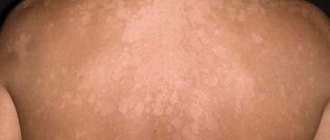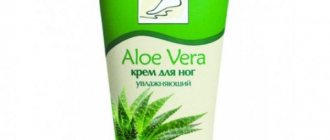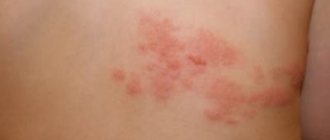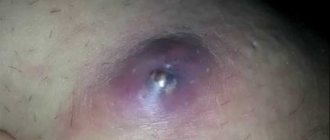Blisters in the groin with herpes type 2
The most likely cause of a vesicular rash is a herpes infection.
It is considered one of the most common STDs, ranking second after trichomoniasis.
Blisters in the groin area do not appear immediately after infection.
The incubation period lasts for 1 week.
This is the time that passes from the moment of sexual contact with an infected partner until the first symptoms appear.
These are the subjective sensations: itching, burning, tingling.
This is the prodromal period, when there is no rash yet.
She appears a day later.
Watery blisters form in the groin, surrounded by an area of hyperemia.
They contain a clear liquid.
Vesicles are grouped.
Almost all of them are formed at the same time.
In the future, if there are any additions, they are insignificant.
Bubbles appear wherever the virus enters the skin.
This can be not only the groin area, but also the labia majora, pubis, and anal area.
In men, watery blisters in the groin are complemented by a vesicular rash on the head of the penis and scrotum.
After a few days the contents become cloudy.
The bubbles become sluggish.
Then they open up.
Ulcers form, which transform into crusts.
After they leave, temporary hyperpigmentation remains.
Herpes infection is not completely cured.
Although its symptoms go away after 1-2 weeks, the virus remains in the body.
Existing drugs do not allow for its complete elimination.
Therefore, for most people, herpes recurs from time to time.
Features of relapses:
- are milder than the primary infection
- may vary in frequency among individuals, occurring within 80% within 12 months of infection
- the severity and frequency of exacerbations correlates with the severity of the initial episode of the disease
How herpes will progress largely depends on the full functioning of the immune system.
In people with strong immunity, bubbles may form in small quantities and last only a few days.
The illness lasts only a few days.
In the future, there are no exacerbations at all, or they are so mild that they go unnoticed.
In people with weak immune systems, the disease is severe and often worsens.
HIV-infected people may experience severe complications, including those associated with brain damage.
Causes and symptoms
Athlete's foot in the groin area, or Hebra's eczema, is a skin pathology caused by the spread of a fungal infection (pathogen: Epidermophyton floccosum). In addition, the development of the disease is facilitated by a number of factors depending on the general condition of the body and the person’s lifestyle.
Eczema Hebra is observed in the area of large folds:
- inguinal-femoral area;
- intergluteal zone;
- under the breasts (in women);
- armpits.
Factors contributing to the occurrence and development of fungal infection:
- mechanical damage to skin tissue (intimate hair removal);
- long-term diaper rash;
- disruption of the endocrine system;
- diabetes;
- excess body weight;
- sweating;
- wearing tight clothes;
- insufficient hygiene;
- poor circulation in the legs and groin area.
These factors cause the development of fungal infection in favorable conditions.
Infection with a pathogenic organism is possible in public swimming pools, saunas, massage rooms if sanitary conditions are not observed, as well as when using other people's personal hygiene products (washcloths, towels).
Symptoms of eczema in the groin:
- the appearance of large reddish spots with clear edges on the inner thighs;
- after redness, the affected areas of the dermis begin to peel off, then blisters with liquid form (seborrheic form);
- spots spread symmetrically, tend to increase in size, affecting a larger area;
- in men, characteristic rashes are observed in the area of the penis, scrotum, and anus;
- in women, the rash is localized in the subglottic region, under the breasts and armpits;
- itching may occur;
- pain upon contact with the skin;
- the maximum spot size reaches 10 cm.
How groin eczema differs in men and women can be seen in the photo.
Are blisters in the groin dangerous due to herpes during pregnancy?
A herpetic infection is extremely unpleasant for most people, but still not dangerous.
But if blisters in a woman’s groin occur during an existing pregnancy, this is an unfavorable prognostic sign.
Surely you know that all expectant mothers are tested for TORCH infections in the first trimester.
The letter “H” in this abbreviation stands for herpes.
This is one of the most dangerous infections of the gestational period.
It can lead to spontaneous abortion, developmental defects, complicated pregnancy, and premature birth.
Sometimes the fetus becomes infected with a herpes infection and develops severe neonatal herpes.
The greatest threat is when a woman becomes infected after conceiving a child.
While a recurrence of herpes is much safer for both the mother and the fetus.
In this case, protective antibodies exist in the blood.
Therefore, although there are risks, they are minimal.
How do you know if you are infected for the first time, or if this is an exacerbation of herpes that you may have been infected with many years ago?
First, you can strain your memory and remember if you have had blisters in your groin before.
Secondly, you must be tested for antibodies to herpes during pregnancy.
If there are IgG antibodies, but not IgM, this is a relapse of herpes, and not a primary infection.
In case of relapse, the risk of intrauterine infection is very small.
But there is a risk of transmitting herpes to the newborn during childbirth.
Therefore, all women who develop blisters in the groin in late pregnancy are subject to drug treatment.
In some cases, the presence of genital herpes becomes an indication for cesarean section.
Otherwise, the child becomes infected.
In the natural course of neonatal herpes, the mortality rate of children reaches 50%.
In the case of the development of a disseminated form of infection, it is even higher – 90%.
After treatment, children usually survive, but neurological impairment may persist.
Blisters in the groin due to heat rash
Miliaria is a reaction of the groin skin to overheating.
There is a blockage of the sweat glands.
Miliaria can be crystalline and red.
In the case of crystalline prickly heat, blockage of the sweat glands occurs at the level of the stratum corneum of the skin.
In this case, small bubbles with transparent contents are formed.
Usually they do not exceed 1 mm in diameter.
Miliaria rubra is an even deeper process.
Therefore, in addition to the blisters, papules appear.
Miliaria itself is not considered a disease.
This is nothing more than a skin reaction to overheating and humidity.
After eliminating the pathogenetic factors, the skin is restored without treatment.
But prickly heat is a predisposing factor for secondary infections.
If bacterial flora attaches, sweat gland abscesses can form.
They require surgical treatment.
Stages of development of herpes in the vagina
The course of the disease is divided into several stages (different methods vary); most specialists use a 4-stage gradation of the disease.
According to it, they distinguish:
- phase 1 (disease development) – discomfort in the groin area, itching, tingling, burning, redness appears on the outer labia, they feel hotter to the touch than healthy areas of the body;
- phase 2 (disease progression) – a rash appears, which is replaced by blisters filled with transparent contents, severe pain is felt, it becomes difficult to walk and sit;
- phase 3 (opening of vesicles) - the bubbles burst, they are replaced by wounds that become covered with a crust;
- phase 4 (final) - the wounds heal without leaving any trace.
The initial stage and all subsequent ones require the woman to maintain intimate hygiene and be careful with her partner, since the infection is transmitted during sexual intercourse. It is advisable to completely abstain from sex during the period of illness and recovery or suggest that your partner use a condom.
It is advisable to completely abstain from sex during the period of illness and recovery or suggest that your partner use a condom.
Blisters in the groin due to dermatitis
Contact dermatitis can cause blisters to form.
This is a form of skin inflammation that is associated with exposure to a toxic substance.
Most often, contact dermatitis occurs on the hands and is associated with work activities.
If bubbles appear in the groin, we are not talking about occupational hazards.
With a high probability, such a lesion is caused by attempts at self-medication, when all kinds of “folk recipes” are used.
Sometimes people try to remove warts and moles with caustic chemical compounds containing alkalis or acids.
The acute form of contact dermatitis develops with short-term exposure to a chemical substance in a toxic dose.
Plaques appear on which there are many small bubbles located nearby.
Some of them are opened.
Therefore, an erosive surface is formed, from which the ichor is released.
Subsequently, the surface dries out and crusts form on it.
Dermatitis can also occur in subacute or chronic form.
But they are not accompanied by the formation of bubbles.
Blisters in the groin due to allergies
An allergic skin reaction is very similar to simple contact dermatitis.
The only difference is that after the skin reddens, papules first appear on it, and only after that do they turn into blisters.
While there are no papules on the skin upon contact with a toxic chemical, blisters form immediately.
An allergy that appears only in the groin and nowhere else is highly likely to have resulted from direct skin contact with an allergen.
The inflammation zone repeats the area where the substance that provoked the reaction came into contact with the skin.
Unlike simple contact dermatitis, the blisters extend somewhat beyond the area of its impact.
Hidradenitis
When the hair follicles become inflamed and the sweat glands work excessively, pimples appear. This disease is called hidradenitis. Purulent formations lead to complications, so there is no need to postpone treatment until later. Small red nodules appear first, causing slight soreness. Then they turn blue, the pain intensifies and their number increases. As a result, purulent pimples are formed. The causative agent is Staphylococcus aureus. It penetrates the skin if a man shaved his groin incorrectly, or did it in unhygienic conditions. The following factors are less likely to influence:
- reduced immunity;
- heavy sweating;
- hormonal fluctuations;
- synthetic underwear.
Bubbles in the groin with pemphigus
Pemphigus is a severe autoimmune disease.
Without treatment, deaths are common.
In most cases, the oral mucosa is primarily affected.
Subsequently, blisters appear throughout the body, including in the groin.
There is no itching.
Blisters on the skin cause pain.
The most typical places for the rash to form:
- scalp
- armpits
- groin
- face
- breast
After the blisters open, painful erosions form.
The elements have different sizes and shapes.
They are arranged randomly.
When you press on the bubble with your finger, its area increases (Nikolsky's symptom).
The disease requires the use of immunosuppressants.
Blisters in the groin due to an STD
Most sexually transmitted infections do not cause blisters in the groin.
The exception is herpes.
Much less often, blisters with purulent contents appear against the background of candidiasis.
Other STDs mostly affect not the skin, but the urethra and internal genital organs.
But sexually transmitted diseases are not only infectious, but also parasitic.
Among them is scabies.
It is caused by the scabies mite.
People become infected through sexual intercourse or through bedding.
There are two main complaints:
- itching
- rash
The rash usually appears as papules.
If bubbles appear, they are caused by a secondary bacterial infection.
They can occur if streptococcus is attached.
Then blisters with flaccid lining and purulent contents appear on the skin.
Prevention
To prevent eczema of the labia, doctors recommend eating a balanced diet, since food allergies are often the cause of eczema, it is advisable to eat natural products. It is recommended to lead an active lifestyle.
Personal hygiene plays a very important role in the prevention of this disease. All products used to care for the genitals must be hypoallergenic. When buying underwear, you need to carefully choose the fabric, since underwear is constantly in contact with the body. Preference should be given to natural fabrics.
What tests should I take for blisters in the groin?
To understand why the bubbles appear, you need to get tested.
The doctor takes a scraping from the rash.
The material is examined using the bacterioscopic method.
It may contain mites, fungi or other pathogens.
Signs of a bacterial infection (for example, streptococcal pyoderma) are also determined.
The most likely cause of the blisters is herpes.
PCR is used to detect the virus.
It allows you to get ahead of the type of herpes virus (first or second).
Often the blisters are caused by allergic reactions.
A doctor can confirm the allergic origin of skin inflammation using a blood test.
In the future, it is important to identify the allergen in order to eliminate further contact with it.
For this purpose, allergy tests are carried out.
But they do this not immediately, but after eliminating the symptoms of skin inflammation.
The person comes to the clinic after 2 weeks.
Various allergens are applied to the skin and the reaction to them is assessed.
If dermatological diseases are suspected, a skin biopsy may be required to verify the diagnosis.
How to anoint the blisters in the groin?
There is no universal ointment that can be applied to the skin and all blisters will go away, regardless of the reasons for their occurrence.
There are a large number of diseases that lead to the formation of vesicles in the groin.
They are all treated differently.
Moreover: the wrong choice of therapy can lead to serious complications.
For example, if a person is trying to treat his allergies, but he actually has streptococcal pyoderma, this will most likely lead to the formation of deep inflammation and an abscess.
Because the antiallergic drugs used suppress the immune system.
The use of antibacterial drugs against the background of an existing fungal infection can aggravate its manifestations.
Because competitors of the fungal flora that inhibit its growth are destroyed.
Thus, therapy can only be prescribed after a thorough diagnosis, otherwise it can be harmful.
If a herpes infection is detected, therapy is carried out with acyclic nucleosides.
The patient is prescribed oral administration of acyclovir or its analogues.
Its use begins as early as possible, ideally during the period of prodromal phenomena.
It is also possible to use topical acyclovir in addition to systemic therapy.
In the future, this drug is prescribed for each relapse of herpes.
For bacterial skin infections, antibiotic ointments are used.
If the depth of inflammation increases, oral antibacterial drugs are indicated.
Streptococcal pyoderma, which causes blisters in the groin, is easy to treat in most cases because streptococci are susceptible to most antibiotics, including penicillins.
For scabies, insecticides are prescribed topically and treatment of clothing and bed linen.
In case of allergy development, local glucocorticoids are used.
Be sure to identify the allergen and eliminate contact with it.
Therapeutic measures
The disease is diagnosed quite simply; the doctor just needs to look at the rash. Next comes the treatment stage, which consists of eliminating the causes that led to the development of prickly heat. First of all, the patient is recommended to get rid of underwear and clothes made of synthetic fabric.
We suggest that you familiarize yourself with Treatment of purulent wounds on the legs: how to treat an injury, antibiotics and other drugs for the treatment of festered injuries
Antibacterial soap will protect your skin from bacteria
It is necessary to maintain hygiene of the damaged areas. Clean the skin only with soft washcloths, use soap for children with an antibacterial effect. In the summer, take a shower at least twice, this will help the rashes go away faster.
Classification of drugs
To relieve itching, ointments with betamethasole and sometimes antihistamines are prescribed.
If a bacterial infection develops (only a specialist can determine it, which is why it is so important to be treated under his supervision), antibacterial drugs are prescribed
With proper treatment and compliance with all medical recommendations, the symptoms of prickly heat will disappear soon, and complete recovery will occur after a couple of weeks.











